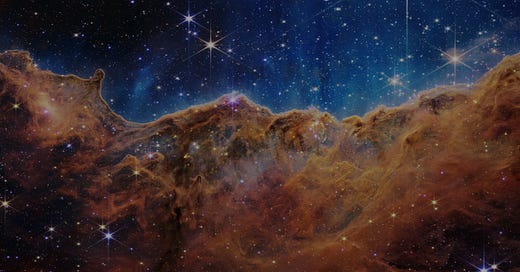Life is Poetry
The neuroscience of poetry and Jan Richardson's Bless the Dust: A Poem for Ash Wednesday

“Poems are not words, after all, but fires for the cold, ropes let down to the lost, something as necessary as bread in the pockets of the hungry.” -Mary Oliver
Hello friend!
Walt Whitman wrote in Leaves of Grass, “dismiss whatever insults your own soul, and your very flesh shall be a great poem.” Our lives, even our bodies, are poetry, but I remember disliking poetry as a young person. In 8th grade English class we studied Edgar Allan Poe and Walt Whitman, analyzing mood, imagery, and underlying themes. We wrote Haiku and memorized The Road Not Taken. I’m embarrassed to admit that for a young girl more interested in Sweet Valley High than in literature or in life’s larger questions, poetry felt boring and tedious. I had not yet lived enough life to appreciate it.
As I’ve grown into adulthood, travelled, worked, parented, loved, lost, laughed and grieved, I’ve come not only to love poetry but to see it as an essential tool for living, healing and embracing being human. Poetry provides an approach to things that can’t be named or explained, much like our experience of God or something greater than ourselves, as suggested by the theopoetics movement, which embraces metaphor, story and song.
Poetry is more than words on a page and the poetic devices that can distract us when we study literature. It has, suggests poet Mary Oliver, “a purpose other than itself”. It can help us make sense of our place in the world and give us solace in the face of questions that we can’t wrap our brains around. This is why poetry is being used in the medical field to help alleviate various health issues ranging from chronic pain to anxiety and depression. Neuroscientists using functional magnetic resonance imagery (fMRI) have discovered that our brains seem to be naturally wired to differentiate poetry from ordinary speech or prose. They've also found that contemplating poetic imagery and the multiple layers of meanings in poems activates specific areas of the brain — some of the same areas that help us to interpret and make meaning of our everyday lives
I believe that poetry will play a central role in healing around the world, as it can bring us into wholeness and unite us with parts of ourselves that are otherwise inaccessible.
What do we do with what we know in our minds but can’t digest in our hearts? What are we to make of the fact that our bodies- and all materiality around us- is made up of former stars - but we still need to load the dishwasher and pick the crumbled crayons up off the rug, not to mention find cures for rare diseases and solve climate change? Our little lives, full of fiery regret, heartbreak and beauty can feel inconsequential. We can feel like the dust we are made of.
This Ash Wednesday and in the spirit of devotion to all that is good in us, consider a few elegant lines of Jan Richardson’s Blessing the Dust, in which the poet unites humanity with the “stuff of which the world is made” in a blessing of our human predicament:
Let us be marked not for false humility or for thinking we are less than we are but for claiming what God can do within the dust, within the dirt, and the stars that blaze in our bones,
In the poem we sense what it is to be both “dust”, “dirt”, capable of being scattered to the edges of the earth and the one that claims “what God can do with the dust”, and “the stars that blaze in our bones.” Only through poetry can we capture this sense of things, more akin to a movement in our peripheral vision than to something we can see or touch. This is a beautiful poem published in the book Circle of Grace: A Book of Blessings for the Seasons, and reading it in its entirety is a must.
Life is poetry. Poetry is life. It is the vehicle by which we can move from the head to the heart and see the good within ourselves, a wild fusion of mind, body, soul and stars.
Reflection
Where are you seeing poetry in your life? What blessing will you ask for?



